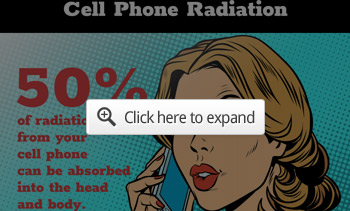STORY AT-A-GLANCE
- A little-known warning from the manufacturer hidden within your cellphone manual advises you to keep the device at a certain distance from your body to ensure you don’t exceed federal safety limits for radiofrequency (RF) exposure
- Depending on the manufacturer, you need to keep your cellphone at least 5 to 15 (0.19 to 0.59 inches) millimeters away from your head and body at all times to avoid exceeding the safety limit for RF exposure
- In the real-world, most people carry their phones close to their body, usually in a pocket or bra. When popular cellphones were tested in direct contact to the body, they all exceeded the safety limit
- SAR is a measure of how much RF energy your body will absorb from the device when held at a specific distance from your body (ranging from 5 to 15 mm, depending on the manufacturer). It’s important to realize that the SAR value is not an indication of how safe your phone is
- SAR testing, which is modeled on a very large male head, was devised before cellphone usage became commonplace among toddlers and young children, whose skulls allow for far greater RF energy penetration
In this special edition of CBC Marketplace, originally aired March 2017, journalist Wendy Mesley investigates the safety of cellphones, focusing on a little-known warning from the manufacturer hidden within your cellphone manual that advises you to keep the device at a certain distance from your body to ensure you don’t exceed the federal safety limit for radiofrequency (RF) exposure.
In the real-world, however, most people carry their phones close to their body, usually in a pocket. Many women even tuck their phone right into their bra which, by the way, is the absolute worst area for a woman to put it, as it could raise their risk of both heart problems and breast tumors, their two leading risks of death.
What the Manufacturer’s Warning Says
While the safe use warning may differ slightly from one phone to the next, the basics remain the same. Mesley reads the information from her iPhone:“To reduce exposure to RF energy, use a hands-free option, such as speakerphone … Carry iPhone at least 5 millimeters [mm] away from your body to ensure exposure levels remain at or below the as tested levels.”According to the report, “81% of Canadians have never seen the message in their phone or manual about carrying their phone 5 to 15 mm away (0.19 to 0.59 inches) from their body.” What’s more, few really understand what it all means. Is it dangerous to have the phone touching your body? Mesley sets out to discover what the warning means for consumers.
The Berkeley Controversy
Mesley visits Berkeley, California, where the city council passed a cellphone “Right to Know” ordinance,1 requiring cellphone retailers to put up signage informing customers that carrying their cellphone in their pocket or bra when the phone is on may result in RF exposure that exceeds federal safety guidelines. The ordinance was initially proposed in 2010 and passed in 2015.In response, the wireless industry (CTIA) sued Berkeley, claiming the ordinance violates free speech rights by forcing retailers to share this information. Considering the information in question is hidden in the manual of every cellphone sold, and is required by federal law, this legal wrangling sure makes it appear as though the manufacturers have hidden the warning on purpose, and really do not want consumers to find or know about it.
What You Need to Know About Your Phone’s SAR Value
As noted by Mesley, whether your phone should be kept 5, 10 or 15 mm away from your body in order to prevent RF exposure exceeding federal safety limits has to do with how the phone was tested. In the film she brings three newly purchased cellphones to RF Exposure Lab in San Marcos, California, one of several labs across the U.S. that conducts specific absorption rate (SAR) testing for cellphones.“Many people mistakenly assume that using a cellphone with a lower reported SAR value necessarily decreases a user’s exposure to RF emissions, or is somehow ‘safer’ than using a cellphone with a high SAR value.
While SAR values are an important tool in judging the maximum possible exposure to RF energy from a particular model of cellphone, a single SAR value does not provide sufficient information about the amount of RF exposure under typical usage conditions to reliably compare individual cellphone models.
Rather, the SAR values collected by the FCC are intended only to ensure that the cellphone does not exceed the FCC’s maximum permissible exposure levels even when operating in conditions which result in the device’s highest possible — but not its typical — RF energy absorption for a user.”
Why SAR Ratings Are Terribly Flawed
In a nutshell, the phone is tested to assess how much RF energy is emitted when used under the worst of conditions. “We’re transmitting as if you were as far away from a base station as you can get and still make a call. This is the worst case it could ever get to be for a cellphone,” the lab technician explains.The testing itself was in fact devised long before cellphone usage became commonplace among toddlers and young children, whose skulls allow for far greater RF energy penetration. With the phone emitting at maximum power, a sensor is then used to measure the depth to which the RF energy is able to penetrate into the dummy head.
All the SAR rating seeks to measure is the short-term thermal effect of the radiation on your body, defined in terms of how much power is absorbed (watts) per unit of tissue (kilogram).
Different types of tissue, such as bone, brain, muscle and blood, all have differing levels of density and conductivity, which also affect the absorption rate. What this means is that a SAR rating is highly dependent on which part of your body is exposed to the radiation.
In the U.S. and Canada, the SAR limit for mobile devices used by the public is 1.6 W/kg per 1 gram of head tissue. There are several major problems with using SAR as our safety guideline.
For starters, the anthropomorphic mannequin (SAM) used to measure SAR is modeled after attributes of the heads of the top 10% of military recruits in 1989 — in other words, a 6-foot, 2-inch-tall, 220-pound male, which is larger than 97% of the American population. This means anyone smaller than SAM is more vulnerable to radiation penetration, especially children.
“RF exposure to a head smaller than SAM will absorb a relatively higher SAR. The SAR for a 10-year-old is up to 153 percent higher than the SAR for the SAM model. When electrical properties are considered, a child’s head’s absorption can be over two times greater, and absorption of the skull’s bone marrow can be 10 times greater than adults.”Secondly, the FCC uses SAM to determine safe levels of ionizing radiation, not noniodizing radiation. Because nonionizing forms of EMF have so much less energy than ionizing radiation, it had long been believed that nonionizing electromagnetic fields were harmless to humans and other biological systems. However, as discussed below, science has shown nonionizing radiation can indeed cause physiological damage.
Government Research Confirms Safety Concerns
Mesley visits Devra Davis Ph.D., who first became aware of the dangers of RF from cellphones and began speaking out about them in 2007. Since then, the scientific literature has doubled in size, and Davis is now more convinced of the dangers than ever.- Clear evidence for heart tumors (malignant schwannomas) in male rats. These types of tumors started developing around week 70, and are very similar to acoustic neuromas found in humans, a benign type of tumor that previous studies have linked to cellphone use.
- Some evidence of brain tumors (malignant gliomas) in male rats. Glial cell hyperplasias — indicative of precancerous lesions — began developing around week 58.
- Some evidence of adrenal gland tumors in male rats, both benign and malignant tumors and/or complex combined pheochromocytoma.
- Equivocal or unclear evidence of tumors in female rats and mice of both genders.
While the NTP insists the exposure — nine hours a day for two years, which is the lifetime of a rodent — is far more extensive than that of heavy cellphone users, I would strongly disagree, seeing how many, especially the younger generation, have their cellphones turned on and near their body 24/7. Many are literally sleeping with their phone beneath their pillow.
NTP Findings Reproduced at Power Levels Below FCC Limits
Corroborating evidence was also published by the Ramazzini Institute just one month after the NTP released its preliminary report in February 2018. The Ramazzini study8 reproduces and clearly supports the NTP’s findings, showing a clear link between cellphone radiation and Schwann cell tumors (schwannomas)9,10 — but at a much lower power level than that used by NTP.To facilitate comparison, the researchers converted their measurements to watts per kilogram of body weight (W/kg), which is what the NTP used. Overall, the radiation dose administered in the Ramazzini study was up to 1,000 times lower than the NTP’s — and below the U.S. limits set by the FCC — yet the results are strikingly similar.
Where Are All the Brain Tumors?
To investigate whether brain tumors are something you need to be concerned with as a cellphone user, Mesley visits neuro-oncologist Dr. Jay Easaw in Edmonton, Canada, who shows her images of one of the worst brain tumors he’s ever seen, located on the side of the brain where the patient — a very heavy cellphone user — held his phone.Easaw has been part of the creation of a brain tumor registry, in the hopes of identifying causes. He believes we’ll see more studies showing a correlation between cellphone use and brain tumors as time goes on and heavy users since childhood start entering adulthood. “There’s no question that we’re seeing more young people coming into the clinic with brain tumors,” he says. “And the question is why.”
Mitochondrial Dysfunction Is the Primary Hazard
While brain tumors may indeed be a concern, in my view, it’s not the primary one. The evidence suggests the primary hazard of cellphone radiation is really systemic cellular and mitochondrial damage,14,15,16,17 which can contribute to any number of health problems and chronic diseases.Heart Problems, Neurological Disorders and Infertility
Cellphone radiation has also been shown to have a significant impact on neurological and mental health,26 contributing to and/or worsening anxiety, depression and dementia, for example, and all of these conditions are rampant and growing more prevalent, even if brain cancer cases are lagging. (This also makes sense as brain dysfunction will occur much faster than a tumor, which can take decades.)Government Is Not Spearheading Public Safety Measures
Again, the harms of RF are not related to heating of tissue but, rather, a result of a cascade of molecular events resulting in severe oxidative damage. As noted earlier, the evidence shows damage can occur even at levels far below the safety limit set for the U.S. and Canada.According to Mesley, more than 200 studies have been submitted to Health Canada showing harm from RF radiation at levels below the safety limit for which cellphones are tested.
Health Canada claims many of these studies simply aren’t good enough to base a decision on, and that “the totality of the science does not support a link to harm.” According to Mesley, Health Canada has even stated that “Even if a small child were exposed to a cellphone 24 hours a day, 365 days a year, there would be no adverse health effects.”
How to Limit Your RF Exposure
While saying there’s no cause for concern, Health Canada still recommends replacing calls with texts, using hands-free devices and limiting use for children if you’re concerned about potential effects.There’s no doubt in my mind that RF exposure from cellphones and other wireless devices is a significant hazard to your health that will damage your DNA and contribute to chronic disease and premature aging. It needs to be addressed if you’re concerned about your health, and that of your family.
To protect yourself and your family from cellphone radiation and other sources of harmful electromagnetic fields, consider taking the following precautions:

References
- 1 Berkeley Cellphone Right to Know Ordinance
- 2 Federal Communications Commission SAR: What It Means For You
- 3 Electromagnetic Biology and Medicine 2011 DOI: 10.3109/15368378.2011.622827 (PDF)
- 4 National Toxicology Program, Draft Reports on Cellphone Radiofrequency Radiation on Rats and Mice
- 5, 7 National Toxicology Program, Cellphone Radio Frequency Radiation Final Report
- 6 Microwave News November 9, 2018
- 8 Environmental Research March 7, 2018
- 9 RF Safe, Press Conference on Ramazzini Study Showing Cancer Cell Phone Radiation Link
- 10 Scientific American March 29, 2018
- 11 Tech Target, Volt Per Meter
- 12 Journal of Environmental and Public Health March 21, 2018
- 13 Microwave News March 25, 2018
- 14 Rev Environ Health. 2015;30(2):99-116
- 15 International Journal of Innovative Research in Engineering and Management, September 2015; 2(5)
- 16 J Cell Mol Med. 2013 Aug;17(8):958-65
- 17 Current Chemical Biology 2016; 10(1): 74-82
- 18 American Brain Tumor Association, Brain Tumor Statistics
- 19 The Heart Foundation, Heart Disease Scope and Impact
- 20, 24 Journal of Cellular and Molecular Medicine 2013; 17(8):958
- 21, 25 The Root Cause in the Dramatic Rise of Chronic Disease, May 2016
- 22, 23 American Journal of Physiology 1996; 1(5): 1494
- 26 Journal of Chemical Neuroanatomy 2016 Sep;75(Pt B):43-51
- 27 Scientific Reports 2017; 7 Article number 17541
- 28 Microwave News December 18, 2017
- 29 American Journal of Epidemiology 1992 Nov 1;136(9):1041-51
- 30 Bioelectromagnetics 1993;14(3):229-36
- 31 PLoS ONE 8(12): e82113
- 32 Journal of Environmental Health Science and Engineering 2015; 13: 34
- 33 Chinese Journal of Integrative Medicine May 2017; 23(5): 345-349
- 34 Environ Int. 2014 Sep; 70C:106-112
- 35 Central European Journal of Urology 2014; 67(1): 65–71
- 36 Fertility and Sterility January 2012; 97(1): 39-45.e2
- 37 FDA.gov, Reducing RF Exposure
- 38 EMF Academy
- 39 Amazon.com Talking Clock
- 40 The Global Healing Center November 13, 2014






